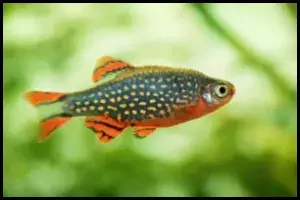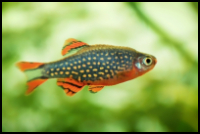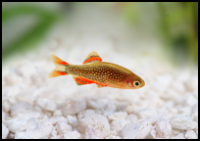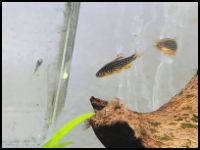





Quick Care Details (Table)
| Livestock Characteristics | Value |
|---|---|
| Care Level | Moderate |
| Temperament | Peaceful |
| Diet | Omnivore |
| Maximum Size | 1 Inches |
| Minimum Tank Size | 10 Gallons |
| Plant Safe | Yes |
| Temperature Range | 72-78F |
| PH Range | 6.5-7.5 |
| KH Range | 8-12 |
Species Specific Categories
Helpful Video
Care Details
Aquascape: To create an ideal environment for Celestial Pearl Danios, aim for a densely planted tank with hiding spots. Floating plants can help filter light and mimic their natural habitat.
Substrate: Choose a fine-grained substrate, like sand, to resemble their native waters and prevent damage to their sensitive barbels.
Disease Prevention: Maintaining water quality, offering a balanced diet, and quarantining new fish are key to preventing diseases. Regular water changes and close observation are essential.
Filtration: Opt for gentle filtration to avoid strong water flow. Sponge filters or low-flow canister filters work well.
Lighting: Moderate lighting is ideal, as it mimics their natural habitat and enhances their colors.
Water Flow: These fish come from slow-moving waters, so ensure gentle water flow by positioning filter outlets thoughtfully.
Hardiness: Once acclimated, Celestial Pearl Danios are generally hardy. Consistent water conditions are key to their well-being.
Acclimation: Take your time when introducing new fish to the tank. Gradually adjust temperature and water parameters to reduce stress and help them adapt successfully.
Expected Lifespan: With proper care, these danios can live around 3-5 years in captivity. Providing a stable environment and quality nutrition contributes to their longevity.
Special Requirements: These peaceful fish thrive in small community tanks with non-aggressive species. Offer hiding spots with live or artificial plants. Maintain water temperature between 73-79°F (22-26°C), a pH of 6.5-7.5, and soft to slightly hard water. While they are low-maintenance, a well-planned setup resembling their natural habitat ensures their comfort and well-being.
document.getElementById("care-details-next-tab").addEventListener("click", function() {
document.getElementById("temperament-tab").click();
});
Temperament and Behavior
Behavior: Celestial Pearl Danios are known for their friendly and active nature. They love to explore their tank, and their vibrant presence adds life to your aquarium.
Breeding: Breeding these danios can be an exciting venture. To encourage breeding, provide them with a well-planted tank, particularly with fine-leaved plants where they can lay their eggs. Their courtship displays are fascinating to observe, but successful breeding might require a separate breeding tank.
Aggression: You'll be happy to know that these danios are among the least aggressive fish. They usually peacefully coexist with other small, gentle fish and seldom engage in aggressive behavior.
Tankmates Compatibility: Celestial Pearl Danios are great team players. They get along well with other small, peaceful species like tetras, rasboras, and calm gouramis. However, always make sure your tank mates are non-aggressive for a harmonious aquarium.
Activity Level: These danios are known for their high activity level. They're constantly on the move, darting and exploring their environment. Their lively swimming patterns are a joy to watch.
Schooling or Shoaling Behavior: Celestial Pearl Danios are social beings and thrive when kept in groups of six or more. They feel secure and exhibit their natural behaviors when in the company of their fellow danios.
Plant Compatibility: You can breathe easy with live plants in the tank. These danios won't munch on them and, in fact, enjoy the shelter and swimming space provided by a well-planted setup.
document.getElementById("temperament-next-tab").addEventListener("click", function() {
document.getElementById("diet-tab").click();
});
document.getElementById("temperament-previous-tab").addEventListener("click", function() {
document.getElementById("care-details-tab").click();
});
Diet and Nutrition
Dry Foods: Celestial Pearl Danios readily accept high-quality dry foods such as micro-pellets and flakes. These are convenient options and provide a balanced diet.
Frozen Foods: They enjoy frozen foods like brine shrimp, daphnia, and bloodworms. These treats offer variety and help enhance their coloration.
Live Foods: Live foods, such as baby brine shrimp and microworms, are highly appreciated by Celestial Pearl Danios. These mimic their natural diet and can be offered as occasional treats.
Vegetables: While they are primarily carnivorous, they may nibble on blanched vegetables like spinach or zucchini occasionally. However, plant matter should be a minor part of their diet.
Algae: They do not eat algae. They are micropredators in their natural habitat.
Feeding Schedule: Feed your Celestial Pearl Danios 2-3 times a day with small, appropriate portions. This prevents overfeeding and helps maintain water quality. They have small mouths, so make sure the food is in tiny pieces.
Supplemental Foods: To keep them healthy and vibrant, offer a well-rounded diet. A combination of dry foods, frozen foods, and live foods ensures they receive essential nutrients. Occasional vegetable matter can be included, but their primary diet should consist of high-protein foods.
document.getElementById("diet-previous-tab").addEventListener("click", function() {
document.getElementById("temperament-tab").click();
});
document.getElementById("diet-next-tab").addEventListener("click", function() {
document.getElementById("tank-parameters-tab").click();
});
Tank Parameters
Tank Size: For a small group of Celestial Pearl Danios, a tank size of at least 10 gallons is sufficient. However, if you plan to keep a larger group or have additional fish, consider a 20-gallon or larger tank to accommodate their active nature.
Tank Length and Measurements: A 10-gallon tank typically measures around 20 inches in length, while a 20-gallon long tank is approximately 30 inches long. These measurements provide ample swimming space for these active fish.
Water Temperature: Maintain a water temperature between 73-79°F (22-26°C) to ensure the comfort and well-being of your Celestial Pearl Danios.
pH (Acidity/Alkalinity): They prefer slightly acidic to neutral water conditions. A pH level between 6.5 and 7.5 is ideal to mimic their native habitat.
KH (Carbonate Hardness) and GH (General Hardness): The KH and GH levels can be moderate to slightly soft. Aim for KH levels around 3-8 dKH and GH levels around 6-12 dGH.
Hardiness: Celestial Pearl Danios are generally hardy fish once they acclimate to your tank conditions. Their hardiness increases with stable water parameters and proper care.
Nitrate (NO3) Levels: To maintain a healthy environment, keep nitrate levels in check. Aim for levels below 20 ppm (parts per million) through regular water changes and efficient filtration.
document.getElementById("tank-parameters-previous-tab").addEventListener("click", function() {
document.getElementById("diet-tab").click();
});
History, Popularity, History and Species Variety Details
History: The Celestial Pearl Danio, scientifically known as Danio margaritatus, made its debut on the aquarium scene in the early 2000s. Discovered in the pristine waters of the Inle Lake region in Myanmar, these dazzling fish quickly piqued the interest of aquarists around the world. Their captivating beauty and peaceful demeanor have since made them a beloved aquarium species.
Popularity: These little gems have skyrocketed in popularity. Aquarists of all levels, from beginners to experts, are drawn to their vibrant colors and striking starry patterns. Their manageable size and compatibility with various tank mates have further fueled their appeal.
Natural Habitat: The Celestial Pearl Danio hails from the serene waters of Southeast Asia, particularly the Inle Lake region in Myanmar. In their native habitat, they thrive in slow-moving waters, often among lush submerged plants. The tranquil beauty of this region mirrors the charm these fish bring to your own aquatic world.
In summary, the Celestial Pearl Danio has made a swift and remarkable journey into the hearts of aquarists worldwide. Their origins in the picturesque waters of Myanmar's Inle Lake region offer a glimpse into the captivating world they represent in your own aquarium.
Male gender vs Female gender (Sexual Dimorphism)
Males:
- Coloration: Male Celestial Pearl Danios typically have more vibrant and intense colors, especially during their breeding displays. They exhibit brighter red and blue hues on their bodies.
- Body Shape: In some cases, males might appear slightly slimmer and more streamlined than females.
- Anal Fin: The front rays of the anal fin in males are often modified into a more pointed and elongated shape. This fin alteration is used during courtship displays.
Females:
- Coloration: Females tend to have slightly less intense colors compared to males. They might display a more subdued coloration, particularly when they're not actively breeding.
- Body Shape: Females are often plumper, especially when they are carrying eggs. This difference in body shape can be more noticeable during the breeding season.
- Anal Fin: The front rays of the anal fin in females are typically shorter and rounder compared to males. This distinction is more noticeable during breeding displays.
Breeding Conditions:
- Separate Breeding Tank: To encourage successful breeding, it's a good idea to set up a dedicated breeding tank. This tank should be thoughtfully arranged with plenty of fine-leaved plants, such as Java moss or spawning mops, where the fish can lay their eggs.
- Water Quality: Maintaining pristine water quality is essential in the breeding tank. Regular water changes and meticulous tank maintenance are essential. Keep the water temperature steady at around 78-80°F (25-27°C).
- Lighting: Opt for soft, subdued lighting in the breeding tank to create a comfortable atmosphere that mimics their natural environment. This can help trigger the spawning behavior.
- Diet: It's crucial to provide the breeding pair with a top-quality diet, including live and frozen foods. This ensures they're in peak condition for breeding.
Breeding Tips:
- Choose Healthy Breeders: Select a robust male and female for breeding. Typically, the female will be slightly larger and plumper than the male.
- Spawning Inducement: You can encourage spawning behavior by gradually raising the temperature in the breeding tank, increasing feeding frequency and variety, and offering numerous hiding spots.
- Egg Laying: The female will lay tiny, adhesive eggs on the fine-leaved plants. These eggs are transparent and somewhat challenging to spot due to their size.
- Separate Adults: To safeguard the eggs, it's advisable to remove the adult fish from the breeding tank after egg laying to prevent them from consuming the eggs.
- Raising Fry: Once the eggs hatch, the fry will be minuscule and require nourishment in the form of tiny foods like infusoria or powdered fry food. As they grow, you can transition to larger food particles.
- Regular Water Changes: Conduct frequent but gentle water changes to preserve water quality and foster the healthy development of the fry.
- Be Patient: Breeding Celestial Pearl Danios can be a bit of a waiting game. It may take some time and observation to understand their breeding behavior fully and fine-tune the conditions for success.
Personal Perspective
Celestial Pearl Danio is a favorite nano fish in the home aquarium. I believe these little guys have some of the best personalities you can find in a nano tank. They remind me of super small red-bellied Sammon, but small enough to fit in any sized aquarium. I have noticed that they do best in large groups; for this type of fish, I would recommend having at least 12 of them. The rule of thumb is the more you have then the more you will see of the fish. You will also be able to enjoy more of their natural behaviors in a larger school. Now, if you were dead set on only having something like the size of them, I have noticed that if you get other types of schooling fish around their size, it will help the CPD feel more comfortable and come out to feed/play more often. If you don't get them in a big school, these guys will almost always hide any time they come across a larger fish or if you ever approach the tank. We all get these wonderful fish specifically so we can see them! In my experience, I would really recommend mixing them with emerald rasbora, ember tetra, or chili rasbora. They all get around the same size and can mix their schools without much stress.
I have also noted that these are some of the easier fish to care for. They have an acceptable wide PH range and other water parameters. These guys could even do well in a tank with no heater as long as you keep your home warm in the winter. They don't need a large tank, so space is almost never a limit for their happiness. They will eat almost anything and are generally aggressive feeders, so you won't have to worry about any other aggressive feeders getting the food before they can get a bite. I have seen that these guys are most interested in grabbing the food directly from the water column, but if a larger piece gets caught at the bottom, they would be open to grab a bite.
If you find yourself interested in breeding and want to take the next step above livebearer fish, these would be your best bet. They only need some soft plant-like material like moss and good tank parameters. They do a little dance on top of it, drop some eggs, and fertilize them as the eggs drop to the bottom of the moss for protection, and I know they need it because, given the chance, they will predate their own eggs and fry. The fry, for the first couple of days, will not move much, which would make them extremely easy to pick. So, I normally place the moss in a plastic container and check for eggs every three or so days. Then i raise the eggs in another tank where they would be safe from predation. This is so much easier than letting the parents lay eggs and then net out all the fish in the aquarium like you need to do for other fish species. This is also beneficial because the parents typically only lay a few eggs at a time, unlike some other species that could do hundreds at once.
So overall, I think these nano fish would be a great addition to any peaceful community tank you have.
Frequently Asked Questions
What's the origin of the Celestial Pearl Danio?
Celestial Pearl Danios, scientifically known as Danio margaritatus, hail from the Inle Lake region in Myanmar, Southeast Asia. Their stunning colors and peaceful nature have made them a sought-after addition to aquariums.
What's the right tank size for Celestial Pearl Danios?
For a small group of Celestial Pearl Danios, a 10-gallon tank is sufficient, but for a larger group, consider a 20-gallon or larger tank to provide ample space for their active nature.
How do I care for Celestial Pearl Danios?
Keep their water temperature between 73-79°F, maintain a pH of 6.5-7.5, and ensure moderate water flow and good filtration. They are peaceful fish that enjoy live or artificial plants, making them a great addition to community tanks.
Can they be bred in a home aquarium?
Yes, they can be bred in a separate breeding tank. Provide them with fine-leaved plants and slightly raise the temperature to induce spawning behavior. After the eggs are laid, remove the adult fish to protect the eggs.
What should I feed Celestial Pearl Danios?
They accept a variety of foods, including high-quality dry foods, frozen foods (like brine shrimp or daphnia), and live foods. A balanced diet ensures their health and vibrant colors.
Are they compatible with other fish?
Celestial Pearl Danios are peaceful and can coexist with other non-aggressive species like small tetras, rasboras, and peaceful gouramis. They prefer to be in groups, so it's a good idea to keep them in a school of six or more.
What's their lifespan?
With proper care, Celestial Pearl Danios can live for about 3-5 years in captivity. Consistent water conditions and a good diet contribute to their longevity.
Can I keep them in a planted tank?
Absolutely! They thrive in well-planted tanks with ample hiding spots and swimming space. Live plants provide a natural feel to their environment.

